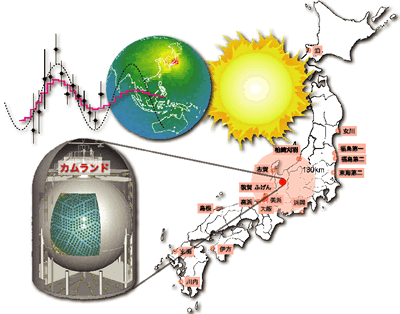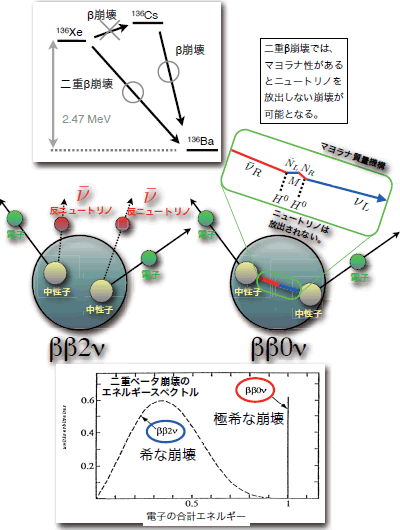Experimental Nuclear and Particle Physics
Experimental Partcle Physics (Neutrino)
https://www.awa.tohoku.ac.jp/rcnse/
Staff
| Professor : | Kunio Inoue | Yasuhiro Kishimoto | ||
| Associate Professor : | Masayuki Koga | Itaru Shimizu | Koji Ishidoshiro | |
| Assistant Professor : | Haruo Ikeda | Hiroko Watanabe | Koichi Ichimura | Haruhiko Miyake |
Research

Non-Accelerator Experiments
The Nature and the Universe provide us with a good laboratory for experiments on particle physics. A plenty of elementary particles are flying around us, some of which have the information of the birth and the evolution of the Universe, and others are continually emitted from the Galaxy, the Sun and the Earth and coming to the ground. The purpose of non-accelerator experiments is to detect these particles and study their characteristics and the Universe. Among the elementary particles, neutrinos interact only through weak interactions and they provide us with direct information of the beginning of the Universe, the interior of the Sun, the end of stars and deep interior of the Earth. Furthermore, the extremely smallness of the neutrino masses and the relation between them are considered to be originated from the grand unified theory of elementary particles and to explain why the Universe is made up by the matter only. The observational studies of neutrinos are therefore very important not only in particle physics but also in astrophysics and geo-physics.

KamLAND experiment
Main purposes of the experiment are to clarify characteristics of neutrinos through detection of reactor antineutrinos, to study radiogenic heat in the Earth’s interior by geo-neutrino detection, and to study evolution of stars by solar neutrino detection. The group constructed the world’s largest detector of 1000ton liquid scintillator in 2002, which is located in the 1000m-deep underground laboratory in Kamioka mine in Hida city in Gifu prefecture. To detect neutrinos the radioactivity surrounding the detector is made extremely low by a factor of several 10 million comparing to that of the ground level. The experiment is carried out 24 hours a day by a collaboration of researchers from the Research Center for Neutrino Science in Tohoku University and several institutes of US.
Firstly the group made a search for periodical transformation of neutrinos (neutrino oscillation) caused by the masses of the neutrinos which are the most fundamental properties of the neutrinos. The group successfully detected the antineutrinos in 2002 coming from distant power reactors at 180km in average away from the detector. The result shows for the first time that the number of observed antineutrinos is less than expected. In 2004, the energy spectrum of the observed antineutrinos is found to be consistent with the neutrino oscillation. This resolves the long-standing solar neutrino problem lasting more than 30 years that the observed solar neutrino fluxes are less than the prediction of the standard solar model. The result is very important to make clear the mass structure and the relation of neutrinos.
Once the fundamental properties of neutrinos became clear, neutrinos can be used to study various mechanisms in nature. The heat generation mechanism in the Earth is a key problem to study the formation and evolution of the Earth, the dynamics of the Earth such as the origin of the Earth magnetism, mantle convection etc. However, it is very hard to understand the mechanism because we cannot directly observe the Earth interior. The KamLAND has successfully detected for the first time antineutrinos which are generated together with the heat by the decays of radioactive elements in deep interior of the Earth. The direct information of the heat generation mechanism obtained by neutrinos means the opening of a new field of science called “Neutrino Geophysics”. Given the large number of nuclear reactors, which are the significant source of background, has been showdown, recent situation is particularly suitable for improving the accuracy of geoneutrino observations.
KamLAND-Zen experiment
The Big bang model predicts equal amounts of matter and antimatter in the early universe. But today, everything we see is made of matter. Why? Neutrinos have a possibility to generate the matter-antimatter asymmetry if neutrinos and anti-neutrinos are same particles. Now there are many experiments going and proposed to solve this mystery. KamALND-Zen is one of such experiments.
The KamLAND-Zen experiment searches for evidence of identity between neutrinos and anti-neutrinos by introducing 136Xe to a part of liquid scintillator. Its evidence is neutrino less double beta decay of 136Xe. We conducted experiment with 380 kg of Xe from 2o11 to 2015 and further sensitive experiment between 2019 to 2024 by introducing larger mini-balloon and increasing Xe to 745 kg. To date, we have placed the world’s most stringent limit on the half-life of neutrinoless double beta decays and have begun examining the inverted mass ordering region of the Majorana mass ahead of competing experiments around the world.
In order to continue to lead competitive experiments, our detector performance needs to be improved. The planed upgrade experiment, “KamLAND2″, will include a high light yield liquid scintillator, high quantum efficiency photomultiplier tubes, and light collection mirror in order to further reduce background by increasing the amount of detected scintillation light and improving the energy resolution. We will start the experiments to discover neutrinoless double beta decay events.
The KamLAND-Zen experiment searches for evidence of identity between neutrinos and anti-neutrinos by introducing 136Xe to a part of liquid scintillator. Its evidence is neutrino less double beta decay of 136Xe. KamLAND-Zen has already set one of the tightest upper limits on half period of neutrino less double beta decay. Several R&D for higher sensitivity by using novel ideas are ongoing in parallel.
Our research group is also developing new experimental and analytical techniques for various physic targets and improving the detection sensitivity.
- Development of imaging detector for particle identification
- Event reconstruction and background identification by machine learning
- Development of scintillation balloon for identification of radioactive background in the balloon film
- Light dark matter search using superconducting sensor and low radioactive dilution refrigerator
- Axion search using resonance cavity
- Development of extremely low radioactive technology for searching extremely rare event
- Development of Ocean Bottom Detector for direct observation of mantle geo-neutrinos
Our research group promotes the KamLAND and KamLAND-Zen experiment, which are international collaborations between Japan, US and Europe, and also actively promotes domestic and international joint research aiming at future evolution of research field.

